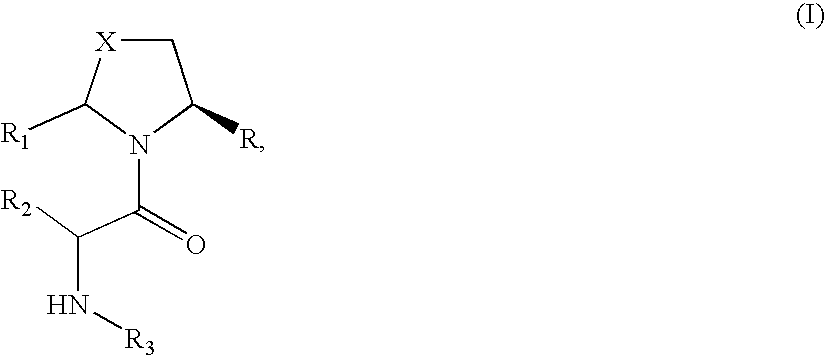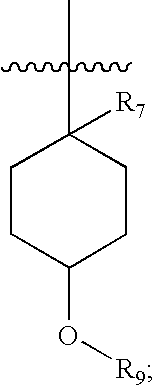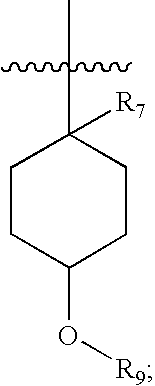Pharmaceutical compositions as inhibitors of dipeptidyl peptidase-IV (DPP-IV)
a technology of dipeptidyl peptidase and composition, which is applied in the field of compound, can solve the problems of short half-life of glp-1 in the circulation (1-1.5 minutes) and is a major obstacle to its use as a therapeutic agent, and achieve the effect of improving glucose toleran
- Summary
- Abstract
- Description
- Claims
- Application Information
AI Technical Summary
Benefits of technology
Problems solved by technology
Method used
Image
Examples
example 1a
dimethyl (2S)-5-oxopyrrolidine-1,2-dicarboxylate
[0327] To a cold (−78° C.) solution of methyl (S)-(+)-2-pyrrolidone-5-carboxylate (4.80 grams, 33.5 mmol) in tetrahydrofuran (90 mL) was added a solution of lithium bis(trimethylsilyl) amide (1 M solution in hexanes, 40.0 mL, 40.0 mmol) dropwise via syringe over 15 minutes; then methyl chloroformate (2.90 mL, 36.9 mmol) was added dropwise via syringe over 5 minutes. The resulting slurry was stirred at −78° C. for 1 hour after which the reaction was quenched with 1 M HCl (50 mL). The mixture was allowed to come to room temperature, concentrated under reduced pressure and the residue partitioned between ethyl acetate (200 mL) and 1 M HCl (200 mL). The aqueous layer was extracted with ethyl acetate (2×200 mL) and the combined organic layers were dried (sodium sulfate), filtered, and concentrated to provide the titled compound. MS (DCI / NH3) m / e 202 (M+H)+; 1H NMR (300 MHz, CDCl3): δ ppm 4.70 (dd, 1H), 3.88 (s, 3H), 3.80 (s, 3H), 2.74-2.30...
example 1b
dimethyl (2S)-5-methoxypyrrolidine-1,2-dicarboxylate
[0328] To a cold solution (−78° C.) of dimethyl (2S)-5-oxopyrrolidine-1,2-dicarboxylate (5.80 g, 28.8 mmol) in tetrahydrofuran (100 mL) was added a solution of lithium triethylborohydride (1 M in THF, 35 mL, 35 mmol) dropwise via syringe over 10 minutes. The resulting solution was stirred at −78° C. for 30 minutes, quenched by the careful addition of saturated sodium bicarbonate solution (50 mL), allowed to warm to 0° C. and 30% hydrogen peroxide (6 mL) was carefully added dropwise. The mixture was stirred for 30 minutes at room temperature, reduced in volume under reduced pressure, and diluted with ethyl acetate (300 mL) and brine (200 mL). The milky aqueous layer was separated and further extracted with ethyl acetate (2×300 mL). The combined organic layers were dried (sodium sulfate), filtered, and concentrated to a light yellow oil. The yellow oil was taken up in methanol (50 mL) containing para-toluenesulfonic acid hydrate (48...
example 1c and 1d
dimethyl (2S,5R)-5-((trimethylsilyl)ethynyl)pyrrolidine-1,2-dicarboxylate and dimethyl (2S,5S)-5-((trimethylsilyl)ethynyl)pyrrolidine-1,2-dicarboxylate
[0329] To a cold −45° C. solution of dimethyl (2S)-5-methoxypyrrolidine-1,2-dicarboxylate (3.30 g, 15.20 mmol) and bistrimethylsilylacetylene (5.20 g, 30.4 mmol, 2.0 equiv) in methylene chloride (45 mL) was added a solution of tin (IV) chloride (1 M in methylene chloride, 20.0 mL, 20.0 mmol, 1.3 equiv) dropwise via syringe over 15 minutes. To the dark yellow solution was added solid aluminum chloride (2.77 g, 20.8 mmol, 1.4 equiv) in one portion. The resulting mixture was allowed to warm to room temperature and stirred at room temperature for 48 hours. The reaction mixture was carefully poured into aqueous sodium bicarbonate solution (100 mL) with ice cooling. A white precipitate forms and 1 M HCl (ca. 50 mL) was added until the solids dissolved. This mixture was extracted with ethyl acetate (2×200 mL). The combined organic layers we...
PUM
| Property | Measurement | Unit |
|---|---|---|
| Dimensionless property | aaaaa | aaaaa |
| Dimensionless property | aaaaa | aaaaa |
Abstract
Description
Claims
Application Information
 Login to View More
Login to View More - R&D
- Intellectual Property
- Life Sciences
- Materials
- Tech Scout
- Unparalleled Data Quality
- Higher Quality Content
- 60% Fewer Hallucinations
Browse by: Latest US Patents, China's latest patents, Technical Efficacy Thesaurus, Application Domain, Technology Topic, Popular Technical Reports.
© 2025 PatSnap. All rights reserved.Legal|Privacy policy|Modern Slavery Act Transparency Statement|Sitemap|About US| Contact US: help@patsnap.com



